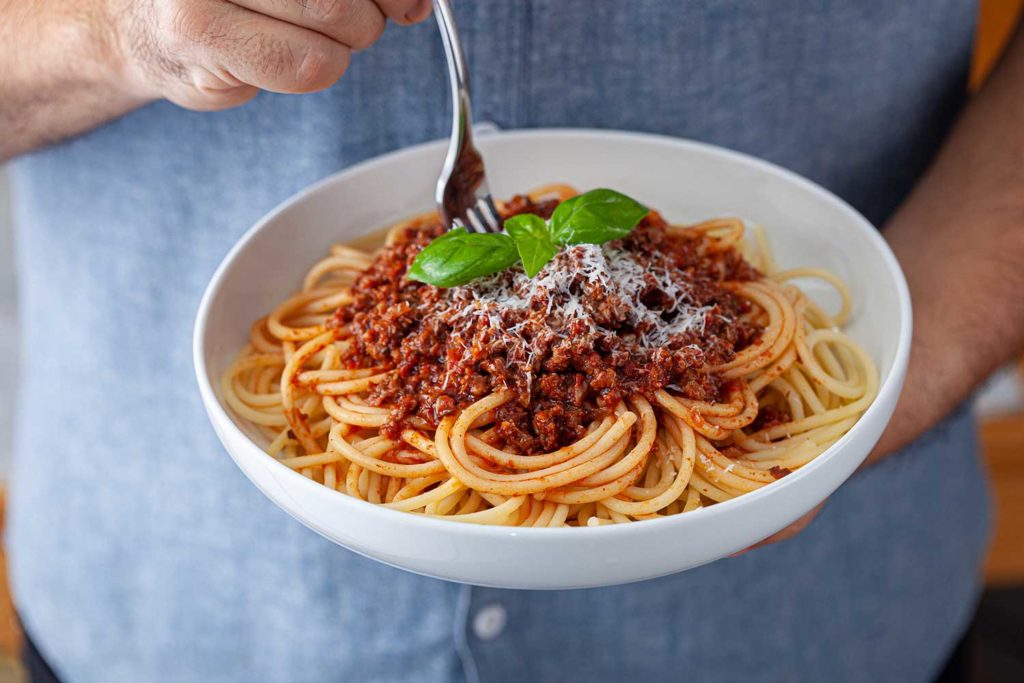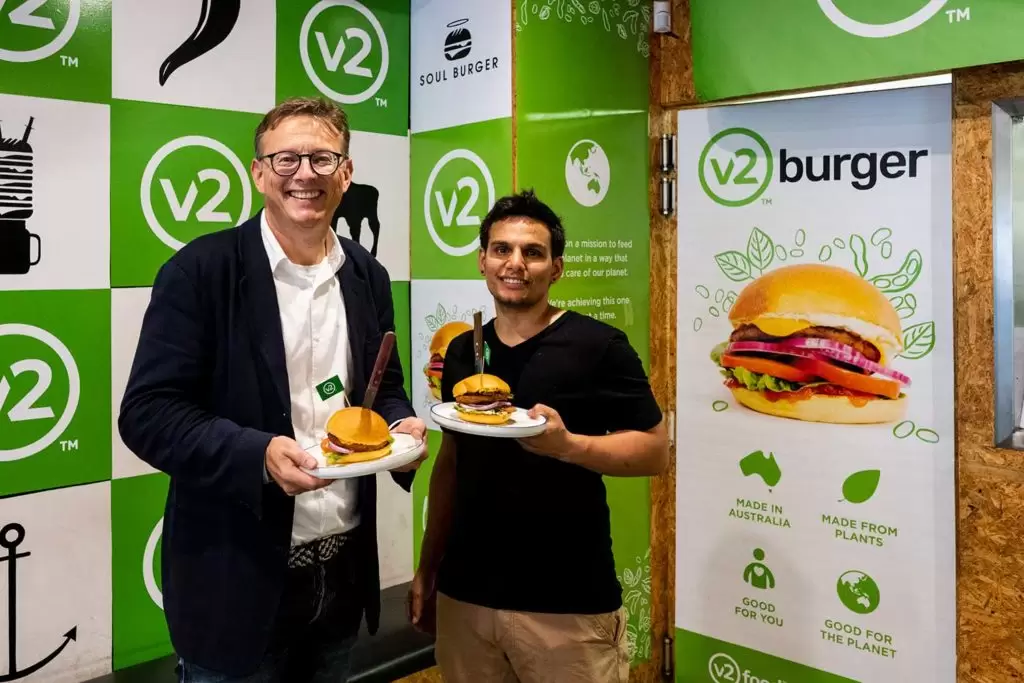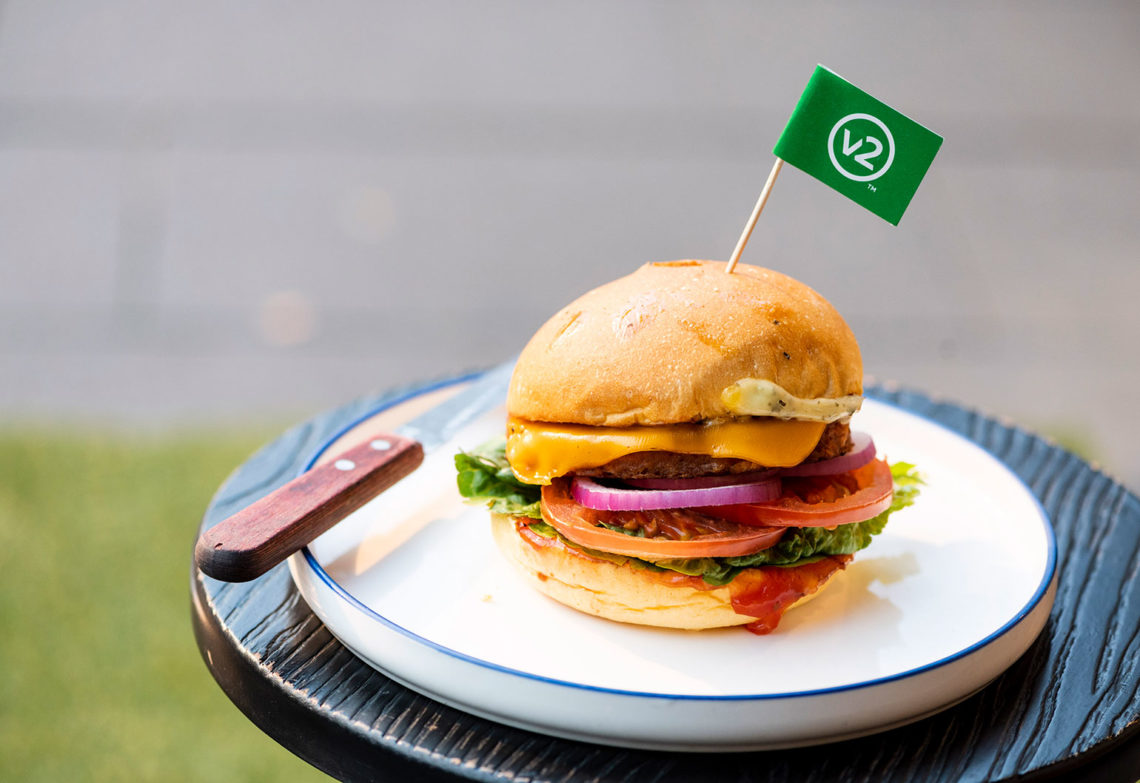Alternative meat startup v2food launched its debut product through Hungry Jack’s. It should be no surprise that its founder has no hostility towards regular meat.
“To feed 10 billion people with the growth of meat consumption, we need another meat industry,” said Nick Hazell, adding that the predicted population in 2050 and the predicted rise in incomes — which generally correspond with increased meat consumption — means we’ll need all the meat we can get.
His company uses chemistry know-how from the CSIRO, in flavours and the interactions between proteins and carbohydrates, to create something that tastes as much like animal meat as possible. It uses ingredients such as plant fibres, soy protein and coconut oils.
Hazell is an aerospace engineer-turned food R&D specialist-turned lecturer and is now heading one of the country’s most exciting businesses in the booming alternative meat category.
When create spoke to him, v2food was preparing to begin full production at its new Wodonga factory, the subject of a $20 million investment and a step up from the pilot line at CSIRO Werribee it was using.
Michelin star chefs in Shanghai were trialling its goods, and its third product, a plant-based pork, was about to come out. And v2 was preparing to hit shelves in Coles and Woolworths.
“Normally that whole journey takes about three years and we seem to be compressing it into months,” Hazell said over Zoom with a shrug.

Plant-based meat has taken eateries and shops by storm. According to one prediction last year by Barclays, alternative meat (including mock meat and cell-based, lab-grown meat) will make up a tenth of the $US 1.4 trillion global meat industry within the decade, up from $US 1.4 billion currently.
CSIRO Futures estimates that Australia could be exporting $2.5 billion worth of alternative proteins by 2030.
V2food is eyeing Asian markets. In general, its target audience is people who are, for whatever reason, trying to eat less meat, rather than no meat whatsoever.
Hazell will often ask for a show of hands while presenting.
Any vegans or vegetarians in the crowd? A few hands.
Any who have tried veganism or vegetarianism and gone back to meat? A few more hands.
Those who are trying to eat less animal flesh will make up around 60 to 70 per cent, by Hazell’s count.
“It doesn’t matter what audience it is. I’ve done this with cattle farmers and I still get sort of 60 or 70 per cent, rather sheepishly they look around and then put their hands up,” he explained.
“Those are our customers. Those are the people who we want to sell to.”
Job number one, making delicious food, is in the bag, he believes. Jobs number two and three — making it affordable through scale and growing a customer base — are works in progress. Number three is a longer-term goal, namely growing enough to make a positive environmental impact through sequestering large amounts of carbon dioxide.
Food production is currently “the single largest driver of environmental degradation” according to the EAT-Lancet Food in the Anthropocene report, which argues for a “radical transformation of the global food system” to meet the United Nations’ Sustainable Development Goals.
Serendipitously, the report was released on 17 January, the day Hazell’s company was officially formed. He calls it his True North.
“We are crazy ambitious, because if we weren’t, we’re just going to be a niche that won’t make any difference,” he said.
“We really do have to get to hundreds of thousands of tonnes equivalent of meat to make any difference on this existential problem.”
Countermeasures and cooking
Hazell struggles to remember exactly what drew him to engineering, other than a talent for maths and a brother in the profession.
“I’ve been a sort of R&D director in food companies for about 20-odd years. So it’s been a long time since I was an aerospace engineer,” he said.
“I was very good at school, and I could have done anything. I think it was because my brother was an engineer, and I was good at Lego.”
He took an apprenticeship “to grow up a bit” before going to the University of Cambridge on a British Aerospace scholarship, finishing with a master’s in manufacturing engineering and beginning as a manufacturing manager at the defence contractor.
“It was actually kind of secret stuff — things that would block other missiles, things that would bug things,” he said.

Hazell went on to work at the famous Slough chocolate factory, the birthplace of the Mars bar, working as a shift manager and then head of continuous improvement engineering. His time at Mars eventually brought him to Australia, before resigning to avoid a promotion that would’ve meant another move.
Then he headed R&D for Pepsico ANZ, before quitting in 2015 to consult and lecture in innovation at the University of Technology Sydney and being tapped in November 2018 to build a new company.
“It’s a circular path, but the stream that goes through it is technical curiosity… and a willingness to try new stuff,” he said.
“Also, food has always been a big part of my life. I’ve always been into cooking food and understanding how things work.”
Down to earth
Hazell tracks some of the sustainability theme back to organising a conference for Mars in conjunction with CSIRO, which informed the company’s eventual adoption of its 2017 Sustainable in a Generation goals.
“I’ve always done lifecycle analyses of products, and I’ve always been amazed that the thing you think you should be focusing on is probably not the most important thing from a carbon footprint perspective,” he said.
When it comes to carbon footprints, there are standout sectors, and 14 per cent of Australian greenhouse emissions are from one of them: agriculture. Seventy per cent of these agricultural greenhouse gasses are from cattle and sheep farming.
One of the selling points of alternative meat is the lower environmental impact compared to feedlot meat.
For example, Beyond Meat in the United States commissioned the University of Michigan to compare its patty to a regular quarter-pounder, from the production of ingredients to packaging disposal.
The study found the imitation meat product created 90 per cent fewer greenhouse emissions, consumed 46 per cent less energy, used 93 per cent less land, and 99.5 per cent less water.
According to v2food, CSIRO recently ran the numbers on its environmental impact, and found the carbon footprint per kilogram of meat similar to other offerings: about 2.5 kilograms of CO2 per 1 kilogram of product.
“A lot of it is in the agricultural inputs and a lot of it’s in the manufacturing: it takes quite a bit of energy to extract the proteins,” Hazell said.
Measures to reduce this include a planned switch to renewable energy, establishing local legume protein processing (proteins are imported from China) and working through the supply chain to offset emissions. Hazell said there’s potential to pay legume farmers to sequester carbon, improving the land in the process.
Hazell cites the warnings in Jared Diamond’s Collapse on Australia’s soil degradation.
“I want to partner with a number of people who have some very innovative ways of getting more carbon back into the soil,” he said.
“Certainly, our roadmap takes us to carbon negative.
“There’s no technical reason why it can’t be done. Just like there’s no technical reason why we can’t rely totally on sustainable energy. We could do it today. It really is not a problem. It’s just a political and an economic issue, and even the economics stack up today. [It’s just that] somebody’s going to have to do it. And we want to be that somebody.”




Great to hear about the growing options for vegans and particularly those who are transitioning away from animal consumption.
Cutting out meat and dairy is the single biggest change an individual can make in the fight against climate catastrophe (Oxford University). However it’s not just the environment that benefits from reduced meat consumption, animal welfare and human health / nutrition also dramatically improves.
Good to see engineers involved in leading this push for a better world!